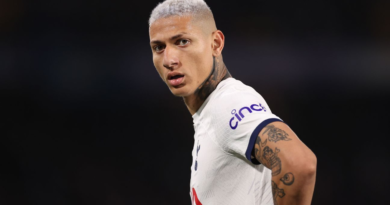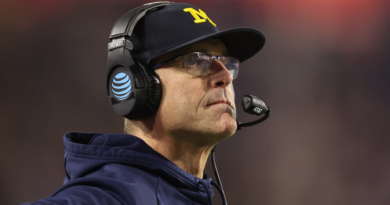Will an antitrust settlement actually settle college sports? Lots of questions remain
The NCAA board of governors and several power conferences have scheduled meetings for next week to vote on a proposed settlement of antitrust lawsuits that would reset the framework for the business of major college sports.
While sources indicate broad support for moving forward with the industry-shifting settlement, athletic department and university administrators are also worried about how effective the negotiated terms will be in creating a stable system. With formal decisions just days away, the chief concern of an industry on the precipice of a historic step is a simple one: Will these settlements actually settle the college sports landscape?
To settle the looming House v. NCAA lawsuit as well as at least two other major federal antitrust claims, multiple sources say the NCAA would pay more than $2.7 billion in damages to past athletes over the next decade. Power conferences would agree to a future system for schools directly sharing revenue with athletes, a permissive choice that’s projected to be in the neighborhood of $20 million per year for each school.
The settlement looms as a quintessential conflicted college sports moment — a bold step with an undercurrent of uncertainty and the new backbone of a multibillion-dollar industry that will forge ahead without key details determined.
Sources told ESPN it would take a minimum of six months, and likely longer, to hash out the unsettled details. Revenue sharing with players is not expected to begin until fall 2025 at the earliest.
“It’s not uncommon that in order to get something across the finish line, you have to agree to leave a whole lot of things unresolved,” an industry source said. “I think the settlement is a good thing, but there are implementation issues that are really significant.”
The list of lingering uncertainties is a long one, including Title IX ambiguity, lack of direction on revenue sharing, the future role of booster collectives and the potential for rosters to be radically reshaped.
At the top of the list of those significant question marks is a concern that the terms of the settlement won’t be sufficient to fend off future legal claims that the NCAA and its schools are violating the law by placing any caps on the way schools can compensate players.
Steve Berman, co-lead counsel for the plaintiffs in the House case, said he believes he has devised a mechanism to solve this issue. Berman has proposed that future athletes — not part of the current class-action lawsuit — would be added to the class on an annual basis. They’d receive an opportunity to opt out of the class or object to the terms of the settlement.
This plan would not give the NCAA legal protection from future antitrust lawsuits, but it would make it much harder to create a large class of athletes suing the NCAA or its schools in the future. The potential financial damages for a case with one or few athletes as plaintiffs would be much smaller, and it would be much less appealing for a future lawyer to dedicate the time and resources to fighting a case that could take years to reach a conclusion.
“What plaintiff lawyer would take that case on behalf of one student?” Berman told ESPN. “It’s unlikely [a future student would sue] because these students are going to get a lot of money, and that lawyer would have to challenge an approved settlement agreement.”
Administrators are right to be cautious about Berman’s proposal, says Marc Edelman, a sports antitrust expert and law professor at Baruch College’s Zicklin School of Business.
Both Edelman and Berman compared the proposed solution to how the NFL handled a labor dispute in the early 1990s in a case called White v. NFL. Edelman, however, said a key difference in that case is that the NFL players agreed to recertify a previously existing players’ union as part of the settlement. Negotiating revenue-share terms with a players’ union — which does not currently exist in college sports — provided the NFL with protection from antitrust claims.
Edelman said it’s possible a judge would not approve a settlement that intentionally creates high barriers for future athletes to file lawsuits.
“If I were a judge, there are aspects of this settlement the way that it’s been reported that would be very concerning,” Edelman said. “…It may make a judge feel that this case moving forward does little if anything to obviate concerns about collusive behavior.”
Berman disagreed, saying the terms are fair to athletes because they can opt out of the settlement.
In addition to lawsuits brought by plaintiff attorneys, the NCAA is also currently being sued by multiple state-elected attorneys general. Settling the House case would not eliminate those threats, which are less dependent on providing lawyers with a financial incentive to pursue action against the NCAA.
Some college sports leaders say they are hoping a settlement that includes significant revenue-sharing money in the future will be enough of a show of good faith that Congress will provide them with an extra layer of antitrust protection to preserve parts of the college sports system. The NCAA and its conferences have been lobbying on Capitol Hill for a bill that would eliminate the threat of future lawsuits — including those that come from state attorneys general — for several years without making much progress.
Multiple sources — in the House and Senate and on either side of the political aisle — have told ESPN in the past week that a settlement this year is unlikely to spur any immediate action from Congress.
“We have to see what those details are,” said Rep. Lori Trahan (D-Mass.), who has introduced multiple bills related to college sports in the past two years. “I’m skeptical, particularly in an election year; it’s just not the highest priority right now.”
Trahan — a former college volleyball player — said she is also skeptical of the motives of college sports officials who have told her they want an antitrust exemption to protect opportunities for women’s sports. She said after receiving those visits, she and her staff often check to see whether the school is currently compliant with Title IX laws that require equal opportunities in sports for men and women. She said she finds they are not complying with the law “a lot, more than I care to admit.”
College sports leaders are also uncertain about how Title IX rules could apply to the future revenue-sharing dollars. The terms of the House settlement do not include any detail about how schools would be required to divide that money, according to multiple sources. The NCAA and its leaders will not have clear answers on their Title IX obligations before voting on the proposed terms of a settlement next week.
And even once the settlement is approved, it appears to set up a landscape that remains unsettled.





